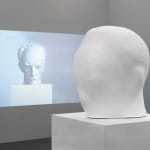 Installation view. "Methuselah" at El Museo del Barrio, New York (October 27, 2022 - March 26,2023). Photography by Martin Seck. Courtesy of El Museo del Barrio.
Installation view. "Methuselah" at El Museo del Barrio, New York (October 27, 2022 - March 26,2023). Photography by Martin Seck. Courtesy of El Museo del Barrio.
 Installation view. "Methuselah" at El Museo del Barrio, New York (October 27, 2022 - March 26,2023). Photography by Martin Seck. Courtesy of El Museo del Barrio.
Installation view. "Methuselah" at El Museo del Barrio, New York (October 27, 2022 - March 26,2023). Photography by Martin Seck. Courtesy of El Museo del Barrio.
 Reynier Leyva Novo next to the original bust (model) of José Martí before the transformation.
Reynier Leyva Novo next to the original bust (model) of José Martí before the transformation.
Reynier Leyva Novo Cuban, b. 1983
What it is, what it has been, 2020
Bust of José Martí by the sculptor Juan José Sicre, after 380 layers of paint.
16 1/2 x 13 3/8 x 13 3/8 in
41.9 x 34 x 34 cm
41.9 x 34 x 34 cm
Edition 1 of 3
6006-1339
Copyright The Artist
Further images
This large-scale figurative sculpture is based on the statue of Cuban independence hero José Martí, created by sculptor Juan José Sire in 1958 for Havana's Plaza Cívica, which was renamed...
This large-scale figurative sculpture is based on the statue of Cuban independence hero José Martí, created by sculptor Juan José Sire in 1958 for Havana's Plaza Cívica, which was renamed Plaza de la Revolución in 1961. The piece reproduces at original scale the sculptures head, which the artist has then covered with 365 lavers of paint. In Cuba, public monuments are periodically repainted as a gesture intended to refresh, update, and honor the subjects depicted. With his exaggeration of this act, the artist blurs the features of this figures face to the point of unrecognizability, resulting in an uncanny and alien-like representation. The piece addresses the habitual re-interpretations of the significance of Marti and other national heroes within the ever-shitting political context of contemporary Cuba, and how the use of monuments as symbolic capital on the island forms part of the propaganda systems of exclusion, censorship, and ideological control.













